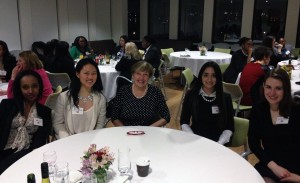Canadian Chapter of the International Association of Women Judges Networking Event with Osgoode
If you are a current student of the Law, Gender, and Equality perspective option, or have perhaps had a conversation with myself in the past week, then you may have participated in a passionate discussion about the sexism that plagues our Canadian judiciary. Or perhaps you are a female student who was lucky enough to have recently attended an event hosted on February 10, 2015 on campus, between female Justices from the

Women Judges
Canadian Chapter of the International Association of Women Judges and female students from Osgoode. The Justices in attendance included Justice Lydia Olah from the Superior Court of Justice, Justice Maria Speyer and Justice Sally Marin of the Ontario Court of Justice, and Justice Katherine Van Rensburg of the Court of Appeal of Ontario. Student attendees of the event were enlightened by stories of the Justices’ law school days and their climb up the legal ladder. Also part of the discussion was the chilly climate in which female members of the judiciary have been welcomed, which has clearly made it difficult for female judges to work on an equal basis with male judges. For simply being educated and assertive women on the bench, judges such as Bertha Wilson, Rosie Abella and Claire L’Heureux-Dube have been victimized by their male counterparts as well as by members of the legal community, the media, and the general Canadian public. Critics claim that female judges’ personal opinions are given in lieu of legal doctrine and principle within their judgments.
While I believe personal history and experience shape a judge’s opinion, I believe it is unfair for attacks to be made on female judges pertaining to their decisions on sexual assault cases and other legal issues that have historically involved mainly female plaintiffs. Using a thought process similar to the kind involved in criticizing female judges, would it not be fair to also criticize the male judges for their personal connections to cases? For example, might we not take into account Justice Sopinka’s connection to the Ukrainian community or perhaps former Chief Justice Dickson’s long-time service in the military?
Further to this point, I was unaware of the extent to which public defamation of such highly decorated and powerful female judges has occurred. The female Justices who were present at the recent Osgoode networking event, discussed the often ignored gendered dynamics that have enveloped the Supreme Court of Canada Justices. Specifically, one Justice discussed the uproar caused by judicial commentary in R v Ewanchuk and the public backlash that Justice Claire L’Heureux-Dube faced regarding her decision in the case. Once an admirer of the late Eddie Greenspan, I am a little less starry-eyed due to the public nature in which he chastised L’Heureux-Dube’s critique of Justice John McClung’s ruling in Ewanchuk.
While we may discuss the gendered dynamics of the judiciary in private conversations with classmates or in classes with an already established gendered approach, I believe such material should be covered in 1L’s Ethical Lawyering course. Discussions of gendered biases on the judiciary would better shape our understandings of the decisions that we read and come to memorize over our years of education and work within the law. In the legal context, is it really fair to say that we can paint every female judge with the same brush of caring femininity and every male judge with a different brush of objective masculinity? While statistics may indicate that women generally display more care for others, this fact not applicable to every legal case, let alone all female judges.
